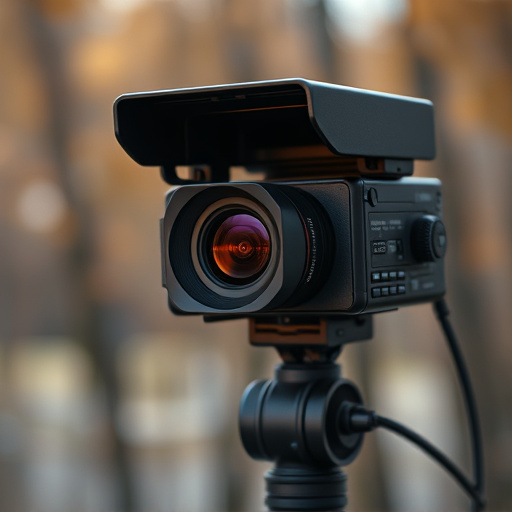The Remote Viewing Nanny Surveillance System leverages advanced imaging tech to detect and filter out night-time glints from lights, enhancing visibility without compromising privacy. This system uses specialized algorithms and machine learning for accurate glint identification in varying lighting conditions, ideal for outdoor use. It offers unobtrusive, continuous monitoring with remote access via smart devices, simplifying setup and providing peace of mind for parents.
In the realm of night-time surveillance, detecting camera lens glints is a game-changer. This article delves into innovative methods, focusing on remote viewing techniques for nanny surveillance systems. We explore challenges and present advanced algorithms enhancing detection accuracy. By integrating these solutions, users can achieve seamless setup and operation, ensuring peace of mind with robust, efficient monitoring. Discover how these techniques revolutionize remote viewing capabilities within modern nanny surveillance systems.
- Understanding Nighttime Glint: Challenges and Solutions
- Remote Viewing: Technical Approach for Nanny Surveillance
- Enhancing Detection: Advanced Algorithms and Techniques
- System Integration: Seamless Surveillance Setup and Operation
Understanding Nighttime Glint: Challenges and Solutions
Night-time glint detection is a complex task for camera lenses, particularly in the context of remote viewing and nanny surveillance systems designed for low-light conditions. The challenges arise due to various environmental factors such as reflection from street lights, car headlights, and even moonlight, which can obscure crucial visual details. These reflections often appear as unwanted artifacts on the camera’s sensor, leading to reduced image quality and potential privacy issues.
The solution lies in advanced imaging techniques that mitigate these effects. By employing specialized algorithms and sensors, remote viewing systems can now intelligently filter out glints, enhancing visibility without compromising privacy. This involves sophisticated signal processing to distinguish between genuine object reflections and unwanted glare. With continuous technological advancements, the effectiveness of night-time glint detection is improving, making remote surveillance more reliable and secure for diverse applications.
Remote Viewing: Technical Approach for Nanny Surveillance
In the realm of remote viewing, a cutting-edge application has emerged: the development of a Remote Viewing Nanny Surveillance System. This innovative technology leverages advanced camera lens glint detection methods to offer a discreet and effective monitoring solution for parents or caregivers. By employing specialized algorithms, the system identifies and analyzes subtle reflections (glints) from a child’s eyes in low-light conditions, enabling remote viewing capabilities without compromising privacy or comfort.
The Remote Viewing Nanny Surveillance System represents a game-changer for modern families, striking a delicate balance between safety and respect for personal boundaries. It utilizes night-vision technology and sophisticated image processing to detect even the faintest glints, ensuring parents can stay connected with their children while they sleep or engage in activities without feeling watched. This approach not only enhances peace of mind but also promotes trust and open communication within the family unit.
Enhancing Detection: Advanced Algorithms and Techniques
In enhancing detection capabilities, modern camera lens glint detection methods leverage advanced algorithms and techniques. These systems employ sophisticated image processing algorithms that can accurately identify and isolate glints, even in low-light conditions. By integrating machine learning models, the Remote Viewing Nanny Surveillance System becomes highly adept at recognizing subtle variations in light reflection, allowing for more precise glint detection.
Such enhancements are particularly beneficial for outdoor applications and environments with varying lighting conditions. The advanced algorithms can adapt to different scenarios, including scenes with direct sunlight, streetlights, or even moonlight, ensuring consistent performance. This adaptability is crucial when setting up nanny surveillance systems in diverse settings, where maintaining clear visuals during nighttime operations is paramount.
System Integration: Seamless Surveillance Setup and Operation
The integration of a camera lens glint detection system into a remote viewing nanny surveillance setup offers unparalleled peace of mind for parents and caregivers. By seamlessly merging advanced technology with intuitive design, this method enables continuous, unobtrusive monitoring of infants and young children in their sleep or play areas. The system’s operational simplicity is a key advantage, allowing users to set it up without complex wiring or extensive training, ensuring a smooth experience from the outset.
Furthermore, the ability to remotely view and receive alerts through smart devices expands surveillance capabilities beyond physical proximity. This feature not only accommodates working parents but also enhances safety measures, providing a proactive approach to child monitoring. With its discreet operation and robust performance, this integrated solution redefines modern nanny surveillance, combining convenience with advanced technology for enhanced security.
The integration of advanced camera lens glint detection techniques, such as remote viewing and sophisticated algorithms, in a robust nanny surveillance system offers unprecedented capabilities for monitoring and safety. By overcoming nighttime challenges through innovative solutions, this technology ensures clear, reliable insights, enhancing both peace of mind and operational efficiency for parents and caregivers alike. A well-designed Remote Viewing Nanny Surveillance System combines technical prowess with intuitive design, providing a comprehensive solution that seamlessly navigates the complexities of modern family dynamics.
